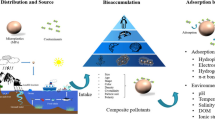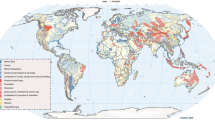Abstract
A new solution for advective-dispersive solute transport of sequentially decaying species is developed for a three-dimensional aquifer of finite thickness, finite width, semi-infinite extent along the direction of flow, dual porosity, equilibrium linear sorption, and first-order decay of both the sorbed and dissolved mass with coefficients that may differ in the mobile and immobile domains, and an arbitrary time-dependent source expressed as a first- or third-type boundary condition over a rectangular patch perpendicular to groundwater flow. The system of equations is solved in closed form in the Laplace domain. The model is benchmarked against a single-species analytical model, MT3DMS, and RT3D. The intended use of the model is to guide the selection of transport parameters for and check the accuracy of more complex numerical solute transport models.






Similar content being viewed by others
Availability of data and material
This work does not contain observations from experiments or field studies. The model for the benchmark simulations described in Sect. 3 can be reproduced using the presented analytical solution and public domain numerical transport models MT3DMS and RT3D.
References
Batu V, van Genuchten MT (1990) First- and third-type boundary conditions in twodimensional solute transport modeling. Water Resour Res 26(2):339–350. 89WR01340. 00-B- : I 397/90/89WR-0 1340S05.00
Bauer P, Attinger S, Kinzelbach W (2001) Transport of a decay chain in homogeneous porous media: analytical solutions. J Contam Hydrol 49:217–39
Bear J (1972) Dynamics of Fluids in Porous Media. Dover Publications, Mineola, NY
Boupha K, Jacobs JM, Hatfield K (2004) MDL Groundwater software: laplace transforms and the De Hoog algorithm to solve contaminant transport equations. Comput Geosci 30:445–453. https://doi.org/10.1016/j.cageo.2004.02.001
Chen JS, Lai KH, Liu CW, Ni CF (2012a) A novel method for analytically solving multi-species advective-dispersive transport equations sequentially coupled with first-order decay reactions. J Hydrol 420–421:191–204. https://doi.org/10.1016/j.jhydrol.2011.12.001
Chen JS, Liu CW, Liang CP, Lai KH (2012b) Generalized analytical solutions to sequentially coupled multi-species advective-dispersive transport equations in a finite domain subject to an arbitrary time-dependent source boundary condition. J Hydrol 456–457:101–109. https://doi.org/10.1016/j.jhydrol.2012.06.017
Chen JS, Liang CP, Liu CW, Li LY (2016) An analytical model for simulating two-dimensional multispecies plume migration. Hydrol Earth Syst Sci 20:733–753. https://doi.org/10.5194/hess-20-733-2016
Chen JS, Ho YC, Liang CP, Wang SW, Liu CW (2019a) Semi-analytical model for coupled multispecies advective-dispersive transport subject to rate-limited sorption. J Hydrol. https://doi.org/10.1016/j.jhydrol.2019.124164
Chen JS, Liang CP, Chang CH, Wan MH (2019b) Simulating three-dimensional plume migration of a radionuclide decay chain through groundwater. Energies 12:3740. https://doi.org/10.3390/en12193740
Churchill RV (1972) Operational mathematics, 3rd edn. McGraw-Hill Book Company, New York
Clement TP (1997) RT3D (Version 1.0) A Modular Computer Code for Simulating Reactive Multispecies Transport in 3-Dimensional Groundwater Systems. Pacific Northwest National Laboratory, PNNL-11720
Clement TP (2001) Generalized solution to multispecies transport equations coupled with a first-order reaction network. Water Resour Res 37(1):157–163
de Hoog FR, Knight JH, Stokes AN (1982) An improved method for numerical inversion of Laplace transforms. SIAM J Sci Statist Comput 3:357–66
Haggerty R, Gorelick SM (1995) Multiple-rate mass transfer for modeling diffusion and surface reactions in media with pore-scale heterogeneity. Water Resour Res 31(1):2383–2400
Leij FJ, Toride N, van Genuchten MT (1993) Analytical solutions for non-equilibrium solute transport in three-dimensional porous media. J Hydrol 151:193–228
Lunn M, Lunn RJ, Mackay R (1996) Determining analytic solutions of multiple species contaminant transport, with sorption and decay. J Hydrol 180(1–4):195–210. https://doi.org/10.1016/0022-1694(95)02891-9
Mieles J, Zhan H (2012) Analytical solutions of one-dimensional multispecies reactive transport in a permeable reactive barrier-aquifer system. J Contam Hydrol 134–135:54–68. https://doi.org/10.1016/j.jconhyd.2012.04.002
Mikhailov MD, Ozisik MN (1984) Unified analysis and solutions of heat and mass diffusion. Wiley, New York
Moench AF (1991) Convergent radial dispersion: a note on evaluation of the Laplace transform solution. Water Resour Res 27(12):3261–3264
Moltz F (2014) Advection, dispersion, and confusion. Groundwater 53(3):348–353. https://doi.org/10.1111/gwat.12338
Neville CJ (1994) Compilation of analytical solutions for solute transport in uniform flow. S.S. Papadopulos & Associates, Inc., Bethseda, MD
Neville CJ (2004) Memorandum: MT3D benchmarking with ATRANS (1). S.S. Papadopulos & Associates, Inc., Bethseda, MD, May, p 4
Neville CJ, Ibaraki M, Sudicky EA (2000) Solute transport with multiprocess nonequilibrium: a semi-analytical solution approach. J Contam Hydrol 44:141–159
Pérez Guerrero JS, Skaggs TH, van Genuchten MT (2009) Analytical solution for multi-species contaminant transport subject to sequential first-order decay reactions in finite media. Transp Porous Media 80:373–387. https://doi.org/10.1007/s11242-009-9368-3
Perina T, Lee TC (2006) General well function for pumping from a confined, leaky, or unconfined aquifer. J Hydrol 317(3):239–60. https://doi.org/10.1016/j.jhydrol.2005.05.020
Petersen JN, Sun Y (2000) An analytical solution evaluating steady-state plumes of sequentially reactive contaminants. Transp Porous Media 41:287–303. https://doi.org/10.1023/A:1006680109002
Quezada CR, Clement TP, Lee KK (2004) Generalized solution to multi-dimensional multi-species transport equations coupled with a first-order reaction network involving distinct retardation factors. Adv Water Resour 27:507–520. https://doi.org/10.1016/j.advwatres.2004.02.013
Simpson MJ, Morrow LC (2015) Analytical model of reactive transport processes with spatially variable coefficients. R Soc Open Sci 2:140348. https://doi.org/10.1098/rsos.140348
Srinivasan V, Clement TP (2008) Analytical solutions for sequentially coupled one-dimensional reactive transport problems—Part I: mathematical derivations. Adv Water Resour 31:203–218. https://doi.org/10.1016/j.advwatres.2007.08.002
Suk H (2013) Developing semianalytical solutions for multispecies transport coupled with a sequential first-order reaction network under variable flow velocities and dispersion coefficients. Water Resour Res 49:3044–3048. https://doi.org/10.1002/wrcr.20230
Suk H (2016) Generalized semi-analytical solutions to multispecies transport equation coupled with sequential first-order reaction network with spatially or temporally variable transport and decay coefficients. Adv Water Resour 94:412–423. https://doi.org/10.1016/j.advwatres.2016.06.004
Sun Y, Petersen JN, Buscheck TA, Nitao JJ (2002) Analytical solutions for reactive transport of multiple volatile contaminants in the vadose zone. Transp Porous Media 49:175–190. https://doi.org/10.1023/A:1016023526537
Sun Y, Petersen JN, Clement TP, Skeen RS (1999) Development of analytical solutions for multispecies transport with serial and parallel reactions. Water Resour Res 35(1): 185–190. 0043-1397/99/1998 WR900003509.000
Wexler E (1992) Analytical solutions for one-, two-, and three-dimensional solute transport in groundwater systems with uniform flow. In Techniques of Water Resources Investigations of the United States Geological Survey, chap. B7, Book 3, Applications of Hydraulics, 53–55
Zheng C, Bianchi M, Gorelick SM (2011) Lessons learned from 25 years of research at the MADE site. Ground Water 49(5):649–662. https://doi.org/10.1111/j.1745-6584.2010.00753
Zheng C, Bennett GC (1995) Applied Contaminant Transport Modeling. Van Nostrand Reinhold, A Division of International Thompson Publishing Inc., New York
Zheng C, Wang PP (1999) MT3DMS A modular three-dimensional multispecies transport model for simulation of advection, dispersion and chemical reactions of contaminants in groundwater systems. U.S, Army Corps of Engineers, Strategic Environmental Research and Development Program, November
Acknowledgements
The author wishes to thank Christopher Neville of S.S. Papadopulos & Associates, Inc., for providing documentation for the benchmark model (Neville 2004); Junqi Huang, Stephen Kraemer, and Matthew Small of the EPA Office of Research and Development for their review of and helpful comments on a draft report documenting this model; and the Associate Editor and two anonymous reviewers whose constructive comments helped improve the manuscript.
Funding
The coding of the analytical solution and the preparation of the benchmark simulations was funded by the U.S. Environmental Protection Agency (EPA) under contract EP-S9-13-02. This manuscript was prepared outside of work funded by and does not represent the views of the EPA.
Author information
Authors and Affiliations
Corresponding author
Ethics declarations
Conflicts of interest/Competing interests
The author does not have any conflicts of interest.
Code Availability
The code will be published in an upcoming EPA report.
Plain Language Summary
A semi-analytical solution is developed for the solute transport of chain-decaying species in a three-dimensional aquifer of finite thickness and dual porosity. Sorption and decay coefficients may differ in the mobile and immobile domains. The source is given by first- or third-type boundary condition with arbitrary time dependency for specified concentration. Benchmark simulations compare the model results against MT3DMS and RT3D.
Appendix
Appendix
The following symbols, with units shown in brackets, are used to represent aquifer and chemical properties and transport parameters. Units are shown as length, mass, and time (L, M, T). Additional symbols for combined variables are defined in the text.
\(a_{x}\), \(a_{y}\), \(a_{z}\) | Dispersivity in the principal directions [L] |
b | Aquifer thickness [L] |
\(C \left( x ,y ,z ,t\right) \) | Concentration [M/L\(^{3}\)] |
\(D_{m}\) | Molecular diffusion coefficient in water [L\(^{2}\)/T] |
\(D_{x} ,D_{y} ,D_{z}\) | Dispersion coefficients in principal directions [L\(^{2}\)/T] |
f | Mass fraction of sorbent in contact with mobile dissolved mass [-] |
K | Distribution coefficient [L\(^{3}\)/M] |
m and i | Subscripts for mobile and immobile regions, respectively; |
Variables without index apply to both regions | |
i | Superscript for i-th species |
q | Darcy flux in the x-direction [L/T] |
w | Aquifer width [L] |
\(\alpha \) | Transfer coefficient for mass exchange between mobile |
and immobile domains [T\(^{ -1}\)] | |
\(\phi \) | Proportion of mobile porosity [-] |
\(\lambda \) | First-order decay coefficient [T\(^{ -1}\)] |
\(\rho \) | Dry bulk density of soil [M/L\(^{3}\)] |
\(\theta \) | Water content (porosity for fully saturated soil) [-] |
\(\theta _{m} =\phi \theta \) | Mobile porosity [-] |
\(\theta _{i} =\left( 1 -\phi \right) \theta \) | Immobile porosity [-] |
Rights and permissions
About this article
Cite this article
Perina, T. Semi-Analytical Three-Dimensional Solute Transport of Sequentially Decaying Species with Mobile-Immobile Regions, Sorption, Decay, and Arbitrary Transient Source. Math Geosci 54, 745–762 (2022). https://doi.org/10.1007/s11004-021-09975-5
Received:
Accepted:
Published:
Issue Date:
DOI: https://doi.org/10.1007/s11004-021-09975-5




